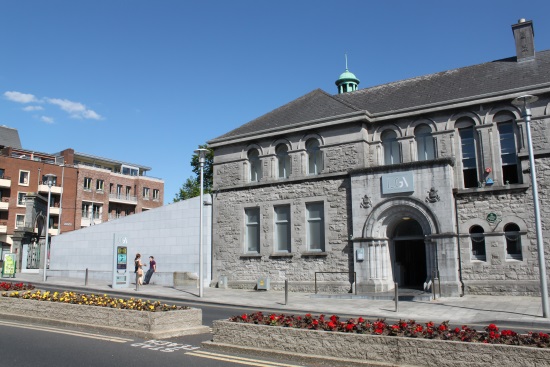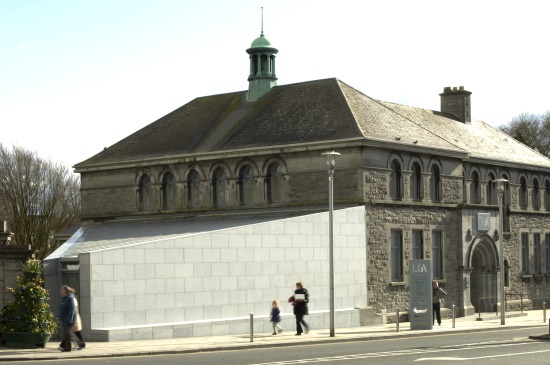Limerick City Galley of Art (LCGA) occupies the historic Neo-Hiberno-Romanesque Carnegie Building, 1906, adjacent to the People's Park and on the 19th century, Georgian styled, Pery Square in Limerick City. The building was funded by Andrew Carnegie (1835 – 1919) as Carnegie Free Library and Museum.In 1936 a group of prominent Limerick politicians, artists and patrons established the first Limerick City Collection of Art from various donations and bequests. In 1948 an extension to the rear of Limerick Free Library and Museum became the home to the City Collection as the Limerick Free Art Gallery. In 1985 the Library and Museum were transferred to larger buildings.Limerick City Gallery of Art has since 1985 occupied the entire Carnegie Building, undergoing two major renovation and expansion in 1999 and in 2010/11.In 2008 LCGA celebrated its sixtieth birthday and in 2009 work commenced on the largest addition to the Carnegie Building since its opening a century before. Limerick’s municipal art collection is one of the finest in the country outside Dublin. Fittingly, the seventy-fifth anniversary of its foundation has been marked by the official opening of the newly extended LCGA on 16th January 2012 by Jimmy Deenihan TD, Minister for Arts, Heritage and the Gaeltacht.In 2012, the Carnegie Building (a protected structure) re-opened with the extended three sides into the People’s Park to house a new storage space for the permanent collection, a café social space, a workshop area and additional public facilities. The extension was designed by Hugh Murray of Limerick (Project Architect) and John A. O’Reilly of County Clare (Design Architect) and funded by the Department of Arts, Heritage and the Gaeltacht through the Access II scheme (designed to assist the provision of high standard arts and culture infrastructure) which provided 70 per cent of the cost and Limerick City Council, which provided the other 30 per cent. The scale of the redevelopment necessitated the closure of LCGA in Pery Square for a period of over a year, during which time parts of the Permanent Collection were exhibited in The Hunt Museum, the Jim Kemmy City Museum and also at Istabraq Hall, City Hall, Merchants Quay. LCGA continued to exhibit its contemporary exhibitions while off-site from Pery Square.Access II funding from the Department of Arts, Heritage and the Gaeltacht was granted to the development, with also funding from City Council. A sculpture - to be called "The Siege of Limerick" - was acquired from internationally renowned, New York-based artist Brian O’Doherty to mark the re-opening in 2012. The acquisition of the ‘triangular’ sculpture has been funded by the ‘Per Cent for Art’ programme, which allows pieces of art to be commissioned or purchased as a complement to an architectural development.In 2012 when LCGA re-opened in Pery Square a major exhibition of works from the Permanent Collection was exhibited throughout the ground floor galleries and was accompanied by a small catalogue booklet. The exhibition was titled A Vivid Imagination LCGA Vivid Imagination catalogue for re-opening 2012 (412 Kb)To accompany the 2012 re-opening Limerick City Council published a small booklet, Limerick City Gallery of Art A Short History written by Dr. Matthew Potter. LCGA A Short History booklet 2012 (800 Kb)https://www.youtube.com/watch?v=Z2Dwhqv8dwM
|
Andrew Carnegie (1835 - 1919) - Industrialist and PhilanthropistAndrew Carnegie was born in 1835 at Dunfermline in Scotland. The advent of the power loom and a general economic downturn reduced the family to poverty and in 1848 they emigrated to the United States, settling at Allegheny in Pennsylvania. Young Andrew began to work at the age of twelve as a bobbin boy in a cotton factory.Carnegie was hard working, shrewd, far sighted and fortunate. As he made more and more money he invested it first of all in railroads and then in iron and steel. He overlooked no new discovery that could improve America's steel production, and by 1890, thanks largely to his endeavours, the United States became the world's largest steel producer. Ten years later Carnegie Steel had annual profits of $40m, of which his personal share was $25m. Then, in the following year, this amazing man sold his company for $250m dollars and devoted the rest of his life to philanthropic activities.Carnegie was far more than just another multi millionaire, he was a social reformer as well. His beliefs, which came to be called the "Gospel of Wealth", were briefly that a man who has accumulated great wealth is obviously an exceptional person; it is his duty to use his surplus wealth for the improvement of mankind. "A man who dies rich, dies disgraced" he snapped. And he proceeded to put his ideas into practice by distributing his own surplus wealth of $350m.As education is one of the keys to success, Carnegie funded the erection of many Public Libraries. In 1913 the Carnegie United Kingdom Trust was established and had already provided 37 libraries in the UK and Ireland. The idea was that the local community, freed from the cost of building, would provide books and maintenance. Alas, things don't always turn out like that. Some libraries were used simply for meetings, some were left empty, some were vandalised. In one case, the caretaker simply burned the books so that he wouldnt be bothered by readers.The Carnegie Free Library in Limerick, a fine building of local limestone, was erected in 1904 and has served the community faithfully as the City Library, Museum and Art Gallery until 1985 when the Library and Museum were transferred and the building became the Limerick City Gallery of Art. |
Carnegie United Kingdom Trust Website




